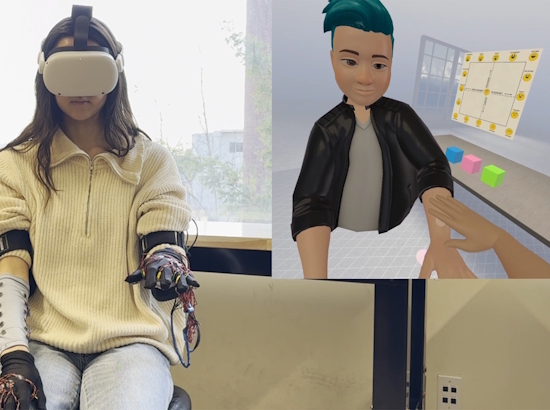[A new wearable haptic system developed at the University of Southern California (USC) provides both a sense of physical presence for multiple virtual reality users as they each interact with objects and social presence as they interact with each other, whether the users are in the same physical location or thousands of miles away from each other. Some of the details are in this news release from USC, where the original version includes two more images. For more information, follow the links to the researchers’ new publication (in the second paragraph) and video. –Matthew]

[Image: Credit: Premankur Banerjee]
New USC haptic technology adds the sense of touch to virtual reality
USC scientists have developed a wearable system that enables more natural and emotionally engaging interactions in shared digital spaces, opening new possibilities for remote work, education, health care and beyond.
By Nina Raffio
July 25, 2025
Touch plays a vital role in how humans communicate and bond. From infancy through adulthood, physical contact helps foster emotional bonds, build trust and regulate stress. Yet in today’s increasingly digital world, where screens mediate many of our relationships, it is often missing.
To bridge the gap, researchers at the USC Viterbi School of Engineering have developed a wearable haptic system that lets users exchange physical gestures in virtual reality and feel them in real time, even when they’re miles apart.
The system includes gloves and sleeves outfitted with small vibration motors that simulate sensations such as pressure and movement. This enables users to perform and feel gestures like pats, handshakes and squeezes within a shared virtual space. Users can also interact with virtual objects and receive realistic vibration feedback.
Findings from a user study testing the technology, published in conjunction with the IEEE World Haptics Conference, showed that participants found virtual interactions more engaging, pleasant and realistic when they could feel gestures.
“Even though people are spending just as much, if not more, time socializing online, we’re seeing rising levels of depression, anxiety and what’s often described as ‘touch starvation,’” said Heather Culbertson, associate professor of computer science and biomedical engineering at USC Viterbi and the study’s corresponding author.
“People will continue interacting virtually — it’s part of modern life. But how can we make online interactions better reflect the social benefits that come from real-world experiences?”
How it works
The system supports up to 16 users simultaneously, each represented by a full-body 3D avatar that mirrors their real-world movements inside a shared virtual environment. Unlike traditional video calls, users can move freely around one another and interact with virtual objects — like passing a cup or completing team tasks.
“This project was born from a simple, deeply human desire: to feel closer to the people we miss,” said Premankur Banerjee, a doctoral student in Culbertson’s Haptics Robotics and Virtual Interaction Lab and first author of the study.
“Having spent over five years away from my own loved ones, this research was more than academic — it was personal,” he added. “It’s about using technology not just to simulate presence, but to restore a sense of physical closeness that’s often lost in long-distance communication.”
To add the sense of touch, users wear gloves and armbands equipped with vibration motors. These devices provide tactile feedback that simulates pressure and motion, allowing users to actually feel gestures and object interactions within the VR space.
Lab tests showed that participants felt a greater sense of presence and social connection when tactile feedback was included. The research also explored how different factors, like gesture speed and vibration type, influenced emotional and sensory experiences, providing insights into how to design more engaging virtual touch interactions.
“Developing this technology requires expertise from many fields,” Culbertson said. “Our team combines computer science, engineering, neuroscience, psychology and social sciences to create hardware and software that not only functions technically but also supports natural, emotionally meaningful social interactions.” (Watch a video from the researchers.)
Reconnecting through touch
The global shift toward online communication — accelerated by the COVID-19 pandemic — has brought undeniable convenience but also unintended consequences. People are more connected than ever digitally, yet feelings of loneliness, anxiety and depression remain high, especially among the nation’s youth.
“While platforms like Zoom and FaceTime have allowed families, friends and colleagues to maintain visual and verbal contact, these modes lack the physicality that humans naturally crave,” Culbertson said.
“While the technology will not replace the experience of in-person contact, it can be a powerful tool to augment social interaction when physical presence is not possible,” she added.
In hospitals and long-term care facilities, the researchers’ system could allow patients and family members to share a comforting touch across distances. In remote and hybrid workplaces and classrooms, it offers more immersive ways to collaborate and engage. For loved ones separated by travel, deployment or circumstance, it brings a deeper sense of closeness.
“Human touch is fundamental to our well-being, and while technology can’t fully replace it, bringing the sense of touch into virtual spaces is a critical step toward more meaningful connection in today’s digital world,” she said.
Leave a Reply